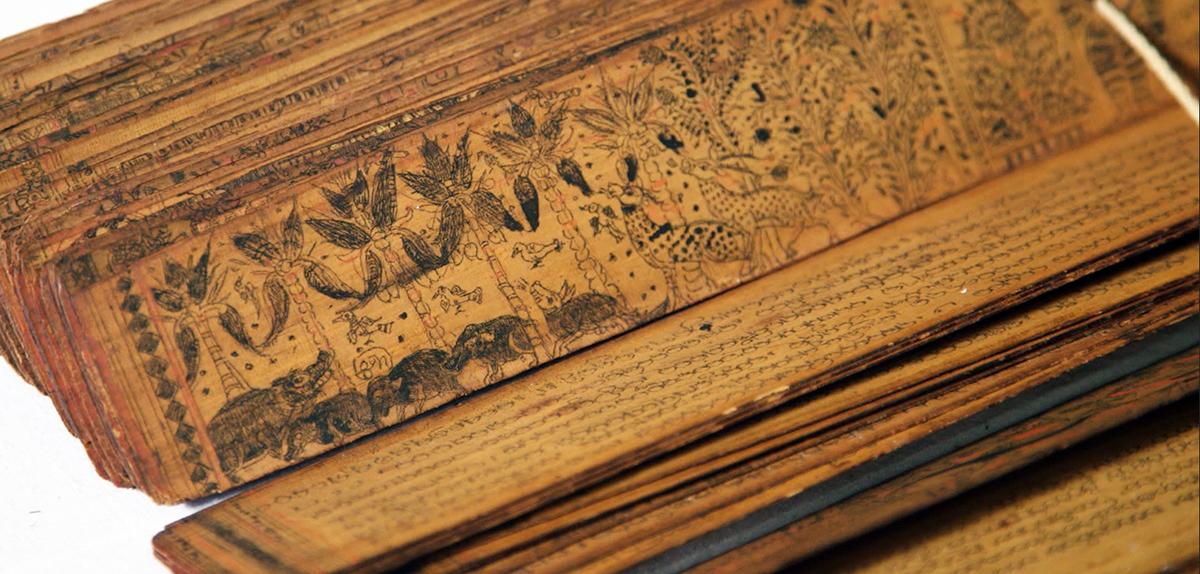You are here
Shiva’s Mysterious Manuscripts
Translation by Jay Swanson
They say that India’s identity was forged in the link between gods and humanity. At times, these divinities have taken different forms, and have been invoked by prayers inspired by everyday life. Yet within the pantheon of Hinduism, one of the principal gods is Shiva, master of destruction and reproduction, the supreme yogi. His cult gave birth to Shivaism, a branch of Hinduism that obeys teachings which have been passed down through the centuries within these mysterious manuscripts.
These sacred texts are studied at the French Institute of Pondichery, in southern India. A team of Indologists watch over the precious collection. Over 8,000 manuscripts are stored within this library. They were gathered by scientists over the 30 years following the founding of the Institute. Each manuscript is made of assembled palm leaves, covered in handwritten inscriptions whose origins date back to the fourth and fifth centuries. among these is the cornerstone of Shivaite teaching: the Agama.
Dr T.Ganesan – Indologist
Agama is a huge corpus of literature, texts, that deal with the particular aspects of god, religion and philosophy incorporating yogic methods, mantras, meditations, worship both external or internal as well as temple public worship. According to this Agama, Shiva is the highest God, supreme God, the only god. And this Agama texts were revealed by Shiva to various other divinities then to sages so thus the religious practices and the philosophical yoga are practiced by the human beings to attend the highest supreme good.
The sanskrit gracing these thin pages composes the combined teachings of the Agama. Through them we find traditional dogma, the description of rituals, and the code of conduct for the faithful and for yoga. Unfortunately, high humidity in these regions quickly causes such manuscripts to deteriorate. Over the centuries, each generation has created new copies to ensure their traditions can carry over into the next generation. Old copies were destroyed to make space for the new, meaning that these manuscripts date back only to the 18th century. Among one of the rarer examples, the copyist left an artistic flourish.
Dr T.Ganesan – Indologist
This text is the story of Ramayana, it is a poetic piece. The poet shows his poetic ability with this embellishments. Some of the scenes connected with the story are drawn on the sides, that’s what we find here : the forest with the wild animals, the demons sometimes they’re drawn, then Rama and Sita there. So here probably the copyist shows his skill in drawing also.
Protected by UNESCO, this collection is now maintained in a dedicated, climate-controlled library. Despite this extra care, the manuscripts still require regular maintenance to prevent their deterioration. Every day, experts work tirelessly to restore life to these fragile pages. The most heavily damaged pages must first be repaired before the entire manuscript is treated with a citronella oil based concoction, which both nourishes the pages and prevents the proliferation of insect larva. After drying for 24 hours, they will return to the shelves of the library, and in doing so, soothe Dr Ganesan’s worried mind.
Different versions of these texts have emerged over time and each successive copy reveals its own variations, additions, or even orthographic errors that researchers at the institute try to identify. It’s a linguistic task across a winding maze of words that often requires the eyes of the institute’s oldest members.
At 92 years old, this brahman comes into the library every day to study these ancient texts. He started copying them 50 years ago, comparing and noting the impressive body of Shivaite manuscripts, during a time when copies were still made by hand.
Sambandhan Sivacharya - Linguist
I was initiated at the age of 20 and, along with many of the other copyists, was entrusted with transferring the palm leaves onto paper. Very often the pages were left in disorder, and they had no page numbers. So before we could even copy them we had to sort them out and put them in order. When we had doubts about a translation, we marked it and referred to the ancient texts.
Reading and copying these manuscripts requires special training. For one, there’s no punctuation, so they’re hard to read. Naturally the idea of reassembling these texts and formatting them into books is essential if we want to enable future generations to access this knowledge.
Dr Ganesan has copied and inventoried the different versions of these texts in order to make them accessible beyond the circles of Shivaite brahmans and initiates. The Department of Indology at the institute will also disseminate these teachings beyond India’s borders, enabling students abroad to access their ancestral knowledge.
In this way the words of Shiva may continue dancing along the lips of his followers.
Saving Shiva's Mysterious Manuscripts
The French Institute of Pondicherry houses thousands of manuscripts related to the worship of the God Shiva, one of the most important theistic traditions of India. We take you to the heart of this fragile and unique collection, inscribed on UNESCO's Memory of the World Register, which continues to fascinate the experts.
Sambandan SIVACHARYA
The French Institute of Pondicherry (IFP)
CNRS / MAEE





